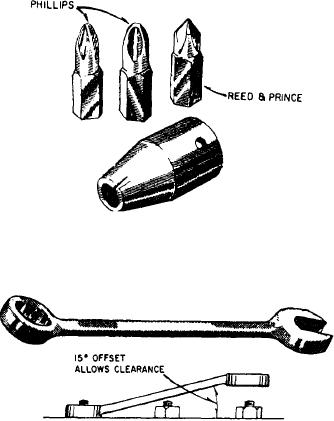
nut to the point where it turns easily, move the
handle into the vertical position, and then turn
the handle with your fingers.
SLIDING T-BAR HANDLE.-- While using
the sliding bar on the T-handle, the head can be
positioned at either the end or the center of the
sliding bar. Select the position that is needed for
the job at hand.
SPEED HANDLE.-- After the nuts are
loosened with the sliding bar handle or the ratchet
handle, the speed handle will help remove the nuts
in a hurry. In many instances, the speed handle
Figure 2-3 .-Screwdriver adapter.
is not strong enough to be used for breaking loose
or tightening. Use the speed socket wrench
carefully to avoid damaging the nut threads.
ACCESSORIES.-- Several accessory items
complete the socket wrench set. Extension bars
of different lengths are made to extend the handles
to any length needed. A universal joint allows the
nut to be turned with the wrench handle at an
angle. A universal socket is also available, and
universal socket joints, bar extensions, and
universal sockets in combination with appropriate
Figure 2-4 .-Combination wrench.
handles make it possible to form a variety of tools
that will reach otherwise inaccessible nuts and
BOX-END WRENCH.-- The box-end fits
bolts.
completely around the nut or bolt head. The
Another accessory item that comes in handy
is an adapter, which allows you to use a handle
box-end is usually constructed with 12 points. The
having one size drive with a socket having a
advantage of the 12-point construction is that the
wrench will operate between obstructions where
different size drive. For example, a 3/8- by
space for the swing angle is limited. A very short
1/4-inch adapter would make it possible to turn
swing of the handle will turn the nut far enough
all 1/4-inch-square drive sockets with any
3/8-inch-square drive handle.
to allow the wrench to be lifted and the next set
There are special sockets that are used to adapt
of points to be fitted to the corners of the nut.
various types of screwdriver bits to a speed handle.
It is possible to use this wrench in places where
the swing angle is limited to as little as 30 degrees.
See figure 2-3. This socket-type screwdriver is used
to remove recessed head screws from access panels
The box-end portion of the wrench is designed
on equipment.
with an offset in the handle. Notice in figure 2-4
how the 15-degree offset will allow clearance over
nearby parts. One of the best features of the box-
Combination Wrenches
end is that there is little or no chance that the
Most toolboxes contain a set of combination
wrench will slip off the nut or bolt. However,
wrenches. As shown in figure 2-4, the combina-
there is the disadvantage of slow work with the
tion wrench has an open-end wrench on one end
box-end of the combination wrench. Each time
and a box-end (of the same size) on the other end.
the wrench is backed off, it has to be lifted up
For speed and light stress operations, use the
and refitted to the head of the work. To save time,
use the nonslip box-end of the wrench to break
open-end. Then switch to the box-end for safety
loose tight bolts or to snug up work after the bolt
under stress. For ease of explanation, each end
of the wrench is discussed separately. Adjustable
has been seated with a faster type of wrench that
wrenches are also briefly discussed.
might slip under stress.
2-5

